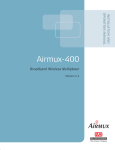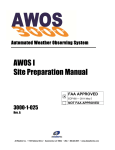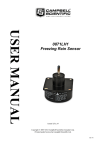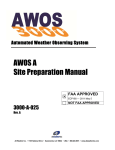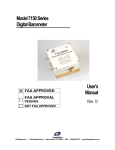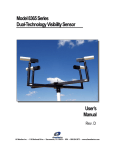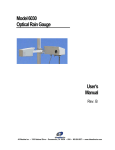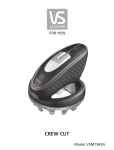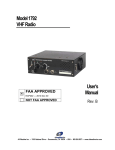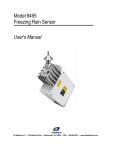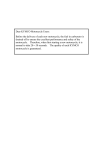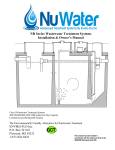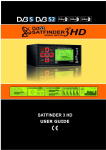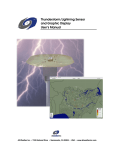Download Model 6496 Freezing Rain Sensor User`s Manual
Transcript
Model 6496 Freezing Rain Sensor User’s Manual Rev. A All Weather Inc. • 1165 National Drive • Sacramento, CA 95834 • USA • 800.824.5873 • www.allweatherinc.com Copyright © 2012, All Weather, Inc. All Rights Reserved. The information contained herein is proprietary and is provided solely for the purpose of allowing customers to operate and/or service All Weather, Inc. manufactured equipment and is not to be released, reproduced, or used for any other purpose without written permission of All Weather, Inc. Throughout this manual, trademarked names might be used. Rather than put a trademark (™) symbol in every occurrence of a trademarked name, we state herein that we are using the names only in an editorial fashion and to the benefit of the trademark owner, and with no intention of infringement. All Weather, Inc. and the All Weather, Inc. logo are trademarks of All Weather, Inc. Disclaimer The information and specifications described in this manual are subject to change without notice. Latest Manual Version For the latest version of this manual, see the Product Manuals page under Reference on our web site at www.allweatherinc.com/. All Weather, Inc. 1165 National Drive Sacramento, CA 95834 Tel.: (916) 928-1000 Fax: (916) 928-1165 Contact Customer Service • Phone support is available from 8:00am - 4:30pm PT, Monday through Friday. Call 916-928-1000 and ask for “Service.” • Online support is available by filling out a request at www.allweatherinc.com/customer/support.html • E-mail your support request to [email protected] Model 6496 Freezing Rain Sensor User’s Manual Revision History Revision A Date 2012 Sept 24 Summary of Changes Initial release. Model 6496 Freezing Rain Sensor User’s Manual TABLE OF CONTENTS 1. OVERVIEW .........................................................................................................................1 1.1 Accessories ................................................................................................................................ 1 2. FUNCTIONAL DESCRIPTION ............................................................................................2 3. DATA COMMUNICATION ...................................................................................................3 3.1 Data Output ............................................................................................................................... 3 3.1.1 Communication Parameters ............................................................................................. 3 3.1.2 Data Format ..................................................................................................................... 3 3.1.3 Poll Command ................................................................................................................. 5 4. UNPACKING AND INSTALLATION ....................................................................................6 4.1 Unpacking.................................................................................................................................. 6 4.2 Installation ................................................................................................................................. 6 4.2.1 Mechanical Mounting ...................................................................................................... 6 4.2.2 Power Connection ............................................................................................................ 8 4.2.3 Data Connection............................................................................................................... 9 4.2.4 Final Steps........................................................................................................................ 9 5. OPERATION ..................................................................................................................... 10 5.1 Power Interruptions ................................................................................................................. 10 5.2 Built-In Test (BIT) Capabilities .............................................................................................. 10 5.2.1 Hardware Built-In Test .................................................................................................. 10 5.2.2 Continuous Built-In Test................................................................................................ 10 5.2.3 BIT Failure That Disables Ice Status Output ................................................................ 11 5.2.4 Initiated Built-In Test (BIT)........................................................................................... 12 5.3 Operator-Initiated Tests ........................................................................................................... 12 5.4 Correlation Counting ............................................................................................................... 12 6. MAINTENANCE ................................................................................................................ 14 6.1 Periodic Maintenance .............................................................................................................. 14 6.1.1 Monthly Maintenance .................................................................................................... 14 6.1.2 Triannual Maintenance .................................................................................................. 14 6.1.3 Annual Maintenance ...................................................................................................... 14 7. TROUBLESHOOTING ...................................................................................................... 15 8. REMOVAL AND REPLACEMENT .................................................................................... 16 10. SPECIFICATIONS .......................................................................................................... 17 11. WARRANTY .................................................................................................................... 19 Model 6496 Freezing Rain Sensor User’s Manual 1. OVERVIEW The Model 6496 Freezing Rain Sensor uses an ultrasonically vibrating probe to detect the presence of icing conditions. The 40 kHz vibrating frequency of the probe decreases as ice, frost, or wet snow accumulate. Once these types of frozen precipitation have accreted on the probe to a thickness of 0.020" (0.5 mm), the frequency decreases by approximately 130 Hz and an internal heater inside the probe assembly turns on to deice the probe. The internal heater draws 35 W during deicing and stays on for 60 seconds. The sensing probe cools within a few seconds. A 24-byte string reporting whether ice is present and status information for the Freezing Rain Sensor is sent to the AWOS Data Collection Platform (DCP) when polled. The DCP combines information from the Freezing Rain Sensor with data from other AWOS sensors to generate reports describing the nature of the freezing rain ice, frost, or wet snow that has accreted on the sensor probe. 1.1 ACCESSORIES The following accessories are available for the Model 6496 Freezing Rain Sensor. Part Number Description M105737-00 Probe Assembly Replacement Gasket M488397-00 Mounting Kit M491742-00 Data Cable (connects Model 6496 Freezing Rain Sensor to DCP) M491745-01 50 ft Power Cable (Model 6496 Freezing Rain Sensor power connector to bare wires) 1 Model 6496 Freezing Rain Sensor User’s Manual 2. FUNCTIONAL DESCRIPTION The Model 6496 Freezing Rain Sensor is mounted on an enclosure containing the power supplies and communication interface (see Figure 1). Extensive internal self-testing identifies problems and provides diagnostic information to indicate whether the sensor is operating properly. Figure 1. Model 6496 Freezing Rain Sensor Enclosure The Probe Assembly (M482221‐00) contains the actual Freezing Rain Sensor probe and its associated electronics. The Power Input Board (M404802-01) accepts AC power and provides 24 V DC to the Freezing Rain Sensor probe and its associated electronics. A 12 V DC power supply also draws its power from the Power Input Board to supply power to the the serial converters that output the RS-422 data from to the Freezing Rain Sensor probe to the RS-485 data output connector on the enclosure. 2 Model 6496 Freezing Rain Sensor User’s Manual 3. DATA COMMUNICATION 3.1 DATA OUTPUT The data is output from the Model 6496 Freezing Rain Sensor over an asynchronous RS-485 interface. The data are output in response to a poll command. 3.1.1 Communication Parameters Table 1 lists the settings for the communication parameters. Table 1. 6496 Freezing Rain Sensor Communication Settings Parameter Setting Baud Rate Data Bits 4800 bps 8 Parity None Stop Bits 1 Handshaking None 3.1.2 Data Format The serial string output from the Model 6496 Freezing Rain Sensor has the following format. Table 2. Freezing Rain Sensor Serial Output String Data Format Byte Bit Definition Comments/Interpretation/Range 7 (MSB) String ID 0 6 0 (first) 5–3 Unused 2 Probe Heater State 1 = Heater ON 0 = Heater OFF 1 Ice Output 1 = Ice 0 = No ice 0 Status Output 1 = Failure 0 = OK (no failure) Oscillator frequency count in hex Frequency = 774060000/Dec (oscillator) 7 Unused 1 = Active 6 Oscillator failure — frequency too high 1–2 (oscillator frequency) 3 (ERRSTAT1) Reserved for future use 3 Model 6496 Freezing Rain Sensor Byte User’s Manual Bit Definition Comments/Interpretation/Range 5 Oscillator failure — frequency too low 4 EEPROM failure 3 RAM failure 2 ROM failure 1 Watchdog Timer failure 0 Power Interrupt Timer failure 7–6 Probe Heater failure 00 = Probe Heater OK 01 = Probe Heater always On or OPEN 10 = Probe Heater always OFF 11 = Probe Heater ON with 1 enable 5 Deicing failure 1 = Active 4–0 Unused 3 (ERRSTAT2) 5–7 (on-time count) Power-On time count (in hex) in 10-minute increments 000000–01FFFF 8–9 (cold start count) Cold Start Power-On count 0000–FFFF 10–11 (ice count) Ice events 0000–FFFF 12 (failures count) Total failures encountered. This number is incremented each time the ice detector transitions from OK to fail. 00–FF 7–4 Oscillator Frequency failure count 0–F 3–0 Heater failure count 0–F 13 (Failure Detail 1) 14 (Failure Detail 2) Not used 15 (Last Error 1) See ERRSTAT1 16 (Last Error 2) See ERRSTAT2 17 (Second Last Error 1) See ERRSTAT1 18 (Second Last Error 2) See ERRSTAT2 4 Model 6496 Freezing Rain Sensor Byte Bit User’s Manual Definition Comments/Interpretation/Range 19 (Permanent Error 1) See ERRSTAT1 20 (Permanent Error 2) See ERRSTAT2 21 (software version) Software Version per VDD/SC1 00–FF 22 (correlation count) 0.01" ice accretion increments since power-on 00–FF 23 (checksum) Summation (1 byte wide) of bytes 0–22 00–FF 3.1.3 Poll Command The poll command is summarized below, where 00 is the address. <CR> and <LF> are a carrier return and line feed. FRRA00<CR><LF> – DCP Poll Command 5 Model 6496 Freezing Rain Sensor User’s Manual 4. UNPACKING AND INSTALLATION 4.1 UNPACKING The Model 6496 Freezing Rain Sensor is a precision instrument and should be handled with extreme care at all times. When the equipment is received, check that all parts listed on the packing slip are accounted for, and inspect the equipment for visible transport damage. Report any damage or discrepancies to All Weather, Inc. Customer Service. Figure 2 shows the protective covers that are around the probe and the probe assembly at the top of the Model 6496 Freezing Rain Sensor enclosure. Do not remove these protective covers until the enclosure installation has been completed. Figure 2. Probe and Probe Assembly Protective Covers 4.2 INSTALLATION The Model 6496 Freezing Rain Sensor must be firmly mounted to a vertical 2½" pipe for proper operation. The Model 6496 Freezing Rain Sensor should be installed in an open area away from trees, buildings, or other obstructions. Mount the Freezing Rain Sensor so that the probe assembly is oriented into the prevailing wind. 4.2.1 Mechanical Mounting Freezing Rain Sensor The Freezing Rain Sensor mounts on the mast using the M488397-00 Mounting Kit. Refer to Figure 3 and Figure 4 during installation. Mount the Freezing Rain Sensor on the mast with the top of the enclosure 5’6" (167 cm) from ground level, or at least 3 feet (1 meter) above the maximum snow level using Mounting Kit M488261-00. 6 Model 6496 Freezing Rain Sensor User’s Manual Ground Cable In order for the Freezing Rain Sensor’s built-in lightning protection to function properly, the Ceilometer must be grounded. To install grounding, follow the steps below (see Figure 3). 1. Drill and tap a ¼ -20 hole in the mast. Install a grounding clamp in the hole. 2. Connect one end of a length of ground cable (4 AWG multi-strand insulated wire, available from All Weather, Inc. as P/N T605000), to the grounding clamp on the mast. 3. Connect the other end of the ground cable to the ground lug on the underside of the Freezing Rain Sensor. 4. Finally, connect a bare copper ground wire between the ground clamp on the mast and an installed ground rod. Figure 3. Freezing Rain Sensor Mounting 7 Model 6496 Freezing Rain Sensor User’s Manual Figure 4. Mast Mounting Details 4.2.2 Power Connection 1. Connect the power cord’s circular connector to the POWER connector on the bottom of the Freezing Rain Sensor enclosure (see Figure 5). 2. Connect the other (unterminated) end of the cable to a suitable AC source in a junction box — BLACK wire is hot, WHITE wire is common, and GREEN wire is ground. It is recommended that power to the junction box be shut off at the breaker panel while the wiring connections are made inside the junction box. Figure 5. Freezing Rain Sensor Connectors 8 Model 6496 Freezing Rain Sensor User’s Manual 4.2.3 Data Connection 1. Connect the data cable’s circular connector to the DATA connector on the bottom of the Freezing Rain Sensor enclosure (see Figure 5). 2. Connect the other (unterminated) end of the cable to the RS-485 connections on terminal block TB4 of the Model 1190 DCP. Connect the GREEN ground wire to pin 7 of terminal block TB4. Connect the BLACK wire (RS-485 +) from the signal cable to pin 1 or 3, and connect the WHITE wire (RS-485 –) to pin 2 or 4 of terminal block TB4. These pin connections are also used for RS-485 connections from other sensors. Wait until all wires from any other sensors have been inserted when connecting more than one wire to a terminal block pin before securing the terminal block screw. 4.2.4 Final Steps 1. Check that the ON/OFF power switch inside the enclosure (Figure 1) is ON. 2. Close and fasten the enclosure door. 3. Remove the two probe protective covers shown in Figure 2. 4. Ensure that the circuit breaker on the breaker panel is in the “ON” position. 9 Model 6496 Freezing Rain Sensor User’s Manual 5. OPERATION The Freezing Rain Sensor operates automatically, and sends data packets to the DCP. There are no controls or indicators on the sensor itself. 5.1 POWER INTERRUPTIONS The Freezing Rain Sensor uses a power-fail monitor to verify the supply voltage. If a power fault lasting more than 200 ms is detected, the Freezing Rain Sensor will report a failure in the STATUS output. 5.2 BUILT-IN TEST (BIT) CAPABILITIES The Freezing Rain Sensor has hardware, continuous, power-up, and operator-initiated tests. Whenever a failure is detected and verified, the Freezing Rain Sensor stops detecting and annunciating icing conditions, and the internal probe heaters are disabled. Failures detected in Initiated and Continuous BIT are counted and enunciated once they have been verified. Failures are verified by delaying (debouncing) the failure for a period of time to minimize or eliminate nuisance errors, Failures detected in Initiated BIT are latched, and power must be cycled off and on to clear a failure. If failures detected in Continuous BIT go away, the probe returns to normal mode, and once again enables all detection functions. 5.2.1 Hardware Built-In Test The hardware BIT consists of a watchdog timer that forces the microcontroller in the Probe Assembly to re-initialize if it does not receive a strobe every 1.6 seconds. An internal voltage monitor forces the microcontroller to the reset state if the internal 5 V DC power supply falls below 4.65 V DC and holds it there until the power supply returns above 4.65 V DC. No output strings are transmitted while the microcontroller is reset. 5.2.2 Continuous Built-In Test The Continuous BIT verifies the following operations. • The internal probe heater is in the correct state. The return leg of the heater is monitored. • The discrete output for ice is in the correct state. This discrete output is fed back to the microcontroller through a passive voltage divider and voltage comparator. • The probe oscillator is operating correctly. Frequencies between 39.00 and 40.15 kHz are valid. • The internal probe heater is deicing correctly. Once it has turned on, the internal probe heater must cause the probe oscillator frequency to return to at least 39.97 kHz within the 25 second timeout, otherwise the internal probe heater is considered to have failed. 10 Model 6496 Freezing Rain Sensor User’s Manual 5.2.3 BIT Failure That Disables Ice Status Output The ice status output is disabled by Continuous and Initiated BIT failures as shown in Table 3. Ice detection is disabled when these failures occur because the integrity of the ice detection capability may be compromised. Table 3. BIT Failure Information Failure Type Ice Detection Disabled Oscillator Failure — Frequency Too High × × Oscillator Failure — Frequency Too Low × × Initiated BIT Continuous BIT × EEPROM Failure RAM Failure × × ROM Failure × × Watchdog Timer Failure × Power Interrupt Timer Failure × Power Fault Monitor Failure × Internal Probe Heater Always ON Active Test Passive Test Internal Probe Heater Always OFF Active Test Passive Test Internal Probe Heater Always ON with 1 Enable × Deicing Failure Clear Only Set Only × Unknown Reset Failure Note 1: The software no longer reports the ice status once a failure is annunciated.. Note 2: In Continuous BIT, the “Internal Probe Heater Always OFF” failure is set when the heater is ON and a deicing failure has been detected. If the frequency indicates that the ice has been removed within the expected time, the software will not annunciate an internal probe heater failure. In this case, the actual failure is most likely caused by a problem in the heater feedback circuitry rather than the heater control circuitry. The failure will be annunciated the next time the Initiated BIT is performed. 11 Model 6496 Freezing Rain Sensor User’s Manual 5.2.4 Initiated Built-In Test (BIT) The Initiated BIT is performed at initial power-up of the Freezing Rain Sensor and following power interruptions that last longer than than 200 ms. The Initiated BIT consists of the following tests: • The ice and fault status outputs are set in the serial output string so monitoring electronics or test equipment can verify activation. • The Freezing Rain Sensor internal probe heater is turned on for a short period of time to verify correct operation of the heater, heater control circuit, and heater feedback circuit. • The correct operation of the watchdog timer is verified by simulating a microcontroller timeout and waiting for a reset input. • Proper ROM operation is verified by computing a checksum of the ROM contents and comparing against a a checksum stored in the ROM. • RAM operation is verified by writing and reading test bytes. • The Power Interrupt Timer is checked by verifying its transitions to a “warm” state after performing a “cold” start. • The power fail input is pulled down to verify a power failure is detected. • Each time the critical data from the EEPROM are read, a checksum is read and compared to the checksum computed from the contents. Each time critical data are written to the serial EEPROM, a checksum is computed and stored with the data. • Resets for unknown reasons (such as reset from the watchdog timer) are detected. 5.3 OPERATOR-INITIATED TESTS The operator can test the freezing rain sensor functionality by squeezing the tip of the probe between the index finger and thumb. This simulates icing by decreasing the frequency of the probe. C A UT ION B e c areful if the probe has jus t been through a deic ing c yc le s inc e it may reac h temperatures up to 204°C . C lean the probe after touc hing it as oil res idue from s kin will affec t the performanc e of the probe. 5.4 CORRELATION COUNTING The Freezing Rain Sensor tracks the ice accumulation on the probe during an icing event. The correlation count helps the Freezing Rain Sensor track the amount of ice that has accumulated on the probe during the icing event. Each correlation count corresponds to a frequency decrease of 65 Hz during the icing event and reflects 0.010" (0.25 mm) of ice buildup. The correlation count, which ranges from 0 to 255, does not take into account the change in collection efficiency caused by ice buildup. The value is no longer incremented once a correlation count of 255 is reached. 12 Model 6496 Freezing Rain Sensor User’s Manual The Freezing Rain Sensor compensates for the operation of the internal probe heater by adding a value (ranging from 0 to 6) to the correlation count when the ice detection cycle is completed The correlation count is reported in Byte 22 of the serial output string (see Error! Reference source not found.). The correlation count is initialized to zero when the Freezing Rain Sensor powers up. 13 Model 6496 Freezing Rain Sensor User’s Manual 6. MAINTENANCE 6.1 PERIODIC MAINTENANCE Tools and Equipment Required • Soft cotton cloth (lint free) • Isopropyl alcohol 6.1.1 Monthly Maintenance Inspect all mounting hardware and cable assemblies for wear and damage; repair or replace as needed. 6.1.2 Triannual Maintenance 1. Inspect all mounting hardware and cable assemblies for wear and damage; repair or replace as needed. 2. Visually inspect the probe surface for contaminants such as dirt, oil, fingerprints, etc. 3. If any contaminants are present, clean probe using isopropyl alcohol and soft cotton cloth. T he freezing rain s ens or probe as s embly will be hot if the s ens or rec ently WA R NING c ompleted a deic e c yc le. E ns ure that the probe as s embly has c ooled before c leaning the probe. While in the deic e mode, the probe will radiate a s ignific ant amount of heat. T his c an be obs erved by plac ing a hand c los e to, but not on, the s ens or probe. A lways avoid direc t c ontac t of the probe with s kin to avoid a potential burn hazard. C A UT ION Do not touc h the probe with bare hands , as oil res idue from s kin will affec t the performanc e of the s ens or. 6.1.3 Annual Maintenance No additional maintenance beyond that described above for monthly and triannual maintenance is required. 14 Model 6496 Freezing Rain Sensor User’s Manual 7. TROUBLESHOOTING Symptom Freezing rain data missing, or “F” displayed for sensor status Possible Causes Loose cable or connector No power to Freezing Rain Sensor Freezing Rain Sensor software locked up Freezing Rain Sensor has failed Freezing rain data intermittent Loose cables or connectors Freezing Rain Sensor is faulty Freezing Rain data inaccurate Freezing Rain Sensor requires maintenance Freezing Rain Sensor has operational errors Freezing Rain Sensor software has locked up Ice fails to melt from probe Freezing Rain Sensor internal probe heater or processor has failed or software has locked up 15 Action Check all cables and connectors. Repair or replace, if necessary Check main power to the sensor is ON Cycle power to sensor. If no recovery, cycle power to the DCP. If no recovery, replace sensor. Consult the SYSLOG for errors prior to the sensor going missing to confirm faulty operation before failure. Replace sensor, if necessary. Check all cables and connectors. Repair or replace, if necessary. Consult the SYSLOG for errors and examine the freezing rain status word for possible causes of the problem. Replace sensor, if necessary. Perform complete maintenance. Cycle power to sensor. If no recovery, cycle power to the DCP. If no recovery, replace sensor. Cycle power to sensor. If data still inaccurate, replace sensor. Cycle power to sensor. If ice still fails to melt, replace sensor. Model 6496 Freezing Rain Sensor User’s Manual 8. REMOVAL AND REPLACEMENT IMPORTANT Observe ESD grounding procedures when handling modules. Do not change modules during weather events; never allow precipitation to enter the interior of the Freezing Rain Sensor. Whenever a module is being changed, the power should be shut off remotely. The only time the power should be on with the Freezing Rain Sensor door open is when checking system operation during troubleshooting. To gain access to the Probe Assembly, open the enclosure door using a screwdriver to release the two latches. Figure 6. Freezing Rain Sensor Probe Assembly 1. The Probe Assembly (part number M482221‐00) is mounted at the top of the Freezing Rain Sensor enclosure. 2. Disconnect the wire connector at the bottom of the Probe Assembly. 3. Remove the four screws securing the Probe Assembly to the top of the Freezing Rain Sensor enclosure. 4. Remove the Probe Assembly from the unit. 5. When installing the new Probe Assembly, replace the gasket (part number M105737-00) before installing the new Probe Assembly and securing it in place with the four screws. 6. Reconnect the wire connector to the bottom of the Probe Assembly. The connector is keyed to facilitate lining up the pins to make the connections correctly. 16 Model 6496 Freezing Rain Sensor User’s Manual 10. SPECIFICATIONS Parameter Specification Set Point Ice signal activates when ice thickness on probe exceeds 0.020 ± 0.005 in (0.5 ± 0.1 mm) Deicing Operates when ice thickness on probe exceeds the set point Discrete Output Signals • Ice signal • Operating status signal Built-In-Test (BIT) • Performed at initial power-up. If a failure is detected and verified, the sensor stops detecting and annunciating ice presence, the probe heaters are disabled; and a failure is annunciated. • Hardware and software BIT verifies that internal electronics are functioning properly during ongoing operation. Output Format Serial Output RS-485 (half duplex) Serial Output Baud Rate 4800 bps Serial Port Parameter Setting 8-N-1 (8 data bits, no parity, 1 stop bit) Conxall® Mini-Con-X® 7280-5SG-300 Field Connector Serial Connector Data Output In response to poll command Electrical 85–265 V AC 47–64 Hz, 50 W Supply Voltage Environmental Operating Temperature -55 to +70ºC (-67 to +158ºF) Storage Temperature -65 to +70ºC (-85 to +158ºF) Humidity 0–100% (noncondensing) 17 Model 6496 Freezing Rain Sensor User’s Manual Parameter Specification Mechanical Mounting Unistrut mounted on single- leg pedestal; 2½" pipe Enclosure NEMA 4X electro-polished 304 stainless steel 20.35" H × 12.00" W × 9.07" D (51.7 cm × 30.5 cm × 23.0 cm) Dimensions (without mounting tabs) Weight 5.5 kg (12 lb) Shipping Weight 7.5 kg (17 lb) 18 Model 6496 Freezing Rain Sensor User’s Manual 11. WARRANTY Unless specified otherwise, All Weather Inc. (the Company) warrants its products to be free from defects in material and workmanship under normal use and service for one year from date of installation or a maximum of two years from date of shipment, subject to the following conditions: (a) The obligation of the Company under this warranty is limited to repairing or replacing items or parts which have been returned to the Company and which upon examination are disclosed, to the Company’s satisfaction, to have been defective in material or workmanship at time of manufacture. (b) The claimant shall pay the cost of shipping any part or instrument to the Company. If the Company determines the part to be defective in material or workmanship, the Company shall prepay the cost of shipping the repaired instrument to the claimant. Under no circumstances will the Company reimburse claimant for cost incurred in removing and/or reinstalling replacement parts. (c) This warranty shall not apply to any Company products which have been subjected to misuse, negligence or accident. (d) This warranty and the Company’s obligation thereunder is in lieu of all other warranties, express or implied, including warranties of merchantability and fitness for a particular purpose, consequential damages and all other obligations or liabilities. No other person or organization is authorized to give any other warranty or to assume any additional obligation on the Company’s behalf, unless made in writing and signed by an authorized officer of the Company. 19 All Weather Inc. 1165 National Drive Sacramento, CA 95818 Fax: 916.928.1165 Phone: 916.928.1000 Toll Free: 800.824.5873 6496-001 Revision A September, 2012



























